A Spectrum-Saving Transmission Method in Multi-Antenna Satellite Communication Star Networks: Sharing the Frequency with Terminals
Abstract
:1. Introduction
- By fully analyzing the characters of the SATCOM star network, we found the transmit and receive gain differences of the antennas equipped at the HS and UTs, which could be equivalent to the channel gain difference for the receiver.
- We proposed a spectrum-saving transmission method where the HS could share the bandwidth with UTs. Thanks to the novel scheme, we do not need to allocate an exclusive frequency band for the UTs, which may spare plenty of spectral resource.
- To facilitate performance evaluation, the expression of ergodic sum rates for the proposed and conventional methods were derived. Furthermore, system availability was also defined to analyze the impact of the accessed UTs, which could help to design a more efficient star network.
2. System Model
2.1. Description of the SATCOM Star Network
2.2. Spectrum Isolation Transmission Method
3. Spectrum-Saving Transmission Scheme
4. Performance Evaluation
4.1. Ergodic Sum Rate of the Spectrum Isolation Method
4.2. Ergodic Sum Rate of the Proposed Method
4.3. Impacts of UTs on System Availability
5. Simulation Results
5.1. Ergodic Sum Rate
5.2. BER Performance
5.3. Impact of M
5.4. Performance Comparison with MF-TDMA
6. Conclusions
Author Contributions
Funding
Data Availability Statement
Conflicts of Interest
References
- Zhang, X.; Zhu, L.; Li, T.; Xia, Y.; Zhuang, W. Multiple-User transmission in space information networks: Architecture and key techniques. IEEE Wirel. Commun. 2019, 26, 17–23. [Google Scholar] [CrossRef]
- Bai, L.; Zhu, L.; Zhang, X.; Zhang, W.; Quan, Y. Multi-Satellite relay transmission in 5G: Concepts, techniques, and challenges. IEEE Netw. 2018, 32, 38–44. [Google Scholar] [CrossRef]
- Kim, J.; Lee, J.; Ko, H.; Kim, T.; Pack, S. Space mobile networks: Satellite as core and access networks for B5G. IEEE Commun. Mag. 2022, 60, 58–64. [Google Scholar] [CrossRef]
- Cao, H.; Zhu, W.; Feng, W.; Fan, J. Robust beamforming based on graph attention networks for IRS-assisted satellite IoT communications. Entropy 2022, 24, 326. [Google Scholar] [CrossRef]
- Chen, S.; Sun, S.; Kang, S. System integration of terrestrial mobile communication and satellite communication-the trends, challenges and key technologies in B5G and 6G. China Commun. 2020, 17, 156–171. [Google Scholar] [CrossRef]
- 3rd Generation Partnership Project (3GPP). Study on Integration of Satellite Components in the 5G Architecture: TR 23.700-28 v0.3.0. 2022. Available online: https://www.5g-mobix.com/assets/files/5G-MOBIX-D6.7-Final-report-on-the-standardisation-and-spectrum-allocation-needs-v1.0.pdf (accessed on 2 December 2022).
- Sun, C. Research status and problems for space-based transmission network and space-ground integrated information network. Radio Eng. 2017, 47, 1–6. [Google Scholar]
- Li, X.; Wang, H.; Zhao, W.; Tian, Q.; Xu, Z.; Yang, B. A new multiple gateway transmit diversity technique for future satellite networks. China Commun. 2022, 19, 214–233. [Google Scholar] [CrossRef]
- Rana, A.H.; McCoskey, J.; Check, W. VSAT technology, trends, and applications. Proc. IEEE 1990, 78, 1087–1095. [Google Scholar] [CrossRef]
- Ma, Y.; Jiang, H.; Li, J.; Yu, H.; Li, C.; Zhang, D. Design of marine satellite communication system based on VSAT technique. In Proceedings of the 2021 International Conference on CITCE, Guangzhou, China, 12–14 November 2021. [Google Scholar]
- Lacoste, C.; Martins, W.; Chatzinotas, S.; Emiliani, L. Inbound carrier plan optimization for adaptive VSAT networks. IEEE Trans. Aerosp. Electron. Syst. 2022. [Google Scholar] [CrossRef]
- Mubarak, R.; Budiyanto, S.; Alaydrus, M.; Adriansyah, A. The utilisation of information systems for VSAT development in rural areas. In Proceedings of the 2020 2nd International Conference on BCWSP, Yogyakarta, Indonesia, 28–30 September 2020. [Google Scholar]
- Al-Wakeel, S.; Al-Wakeel, M. An architecture design of a VSAT satellite network for multimedia on demand services. In Proceedings of the 2000 IEEE WCNC, Chicago, IL, USA, 23–28 September 2000. [Google Scholar]
- Hadjitheodosiou, M.; Coakley, F.; Evans, B. Next generation multiservice VSAT networks. Electron. Commun. Eng. J. 1997, 9, 117–126. [Google Scholar] [CrossRef] [Green Version]
- Bugaj, M. Veryfication of multi-access techniques for VSAT satellite terminals. In Proceedings of the 2018 PIERS-Toyama, Toyama, Japan, 1–4 August 2018. [Google Scholar]
- Zhu, X.; Jiang, C.; Yin, L.; Kuang, L.; Ge, N.; Lu, J. Non-orthogonal multiple access based integrated terrestrial-satellite networks. IEEE J. Sel. Areas Commun. 2017, 35, 2253–2267. [Google Scholar] [CrossRef]
- Zhu, X.; Jiang, C.; Yin, L.; Kuang, L.; Ge, N.; Lu, J. Cooperative multigroup multicast transmission in integrated terrestrial-satellite networks. IEEE J. Sel. Areas Commun. 2018, 36, 981–992. [Google Scholar] [CrossRef]
- Yan, X.; Xiao, H.; An, K.; Zheng, G.; Tao, W. Hybrid satellite terrestrial relay networks with cooperative non-orthogonal multiple access. IEEE Commun. Lett. 2018, 22, 978–981. [Google Scholar] [CrossRef] [Green Version]
- Yue, X.; Liu, Y.; Yao, Y.; Li, T.; Li, X.; Liu, R.; Nallanathan, A. Outage behaviors of NOMA-based satellite network over Shadowed-Rician fading channels. IEEE Trans. Veh. Technol. 2020, 69, 6818–6821. [Google Scholar] [CrossRef] [Green Version]
- Li, T.; Hao, X.; Yue, X. A power domain multiplexing based co-carrier transmission method in hybrid satellite communication networks. IEEE Access 2020, 8, 120036–120043. [Google Scholar] [CrossRef]
- He, G.; Gao, X.; Sun, L.; Zhang, R. A review of multibeam phased array antennas as LEO satellite constellation ground station. IEEE Access 2021, 9, 147142–147154. [Google Scholar] [CrossRef]
- Vázquez, M.Á.; Blanco, L.; Pérez-Neira, A.I. Spectrum sharing backhaul satellite-terrestrial systems via analog beamforming. IEEE J. Sel. Top. Signal Process. 2018, 12, 270–281. [Google Scholar] [CrossRef] [Green Version]
- Moon, S.; Yun, S.; Yom, I.; Lee, H. Phased array shaped-beam satellite antenna with boosted-beam control. IEEE Trans. Antennas Propag. 2019, 67, 7633–7636. [Google Scholar] [CrossRef]
- Alves, H.; Riihonen, T.; Suraweera, H.A. Full-Duplex Communications for Future Wireless Networks; Springer: Singapore, 2020. [Google Scholar]
- Maral, G.; Bousquet, M.; Sun, Z. Satellite Communications Systems: Systems, Techniques and Technology, 6th ed.; Wiley: West Sussex, UK, 2020; pp. 6–10. [Google Scholar]
- Liang, X.; Jiao, J.; Wu, S.; Zhang, Q. Outage analysis of multirelay multiuser hybrid satellite-terrestrial millimeter-wave networks. IEEE Wirel. Commun. Lett. 2018, 7, 1046–1049. [Google Scholar] [CrossRef]
- Bai, L.; Li, T.; Xiao, Z.; Choi, J. Performance analysis for SDMA mmWave systems: Using an approximate closed-form solution of downlink sum-rate. IEEE Access 2017, 5, 15641–15649. [Google Scholar] [CrossRef]
- Suraweera, H.A.; Smith, P.J.; Shafi, M. Capacity limits and performance analysis of cognitive radio with imperfect channel knowledge. IEEE Trans. Veh. Technol. 2010, 59, 1811–1822. [Google Scholar] [CrossRef]
- He, Y.; Liu, Y.; Jiang, C.; Zhong, X. Multiobjective anti-collision for massive access ranging in MF-TDMA satellite communication system. IEEE Internet Things J. 2022, 9, 14655–14666. [Google Scholar] [CrossRef]
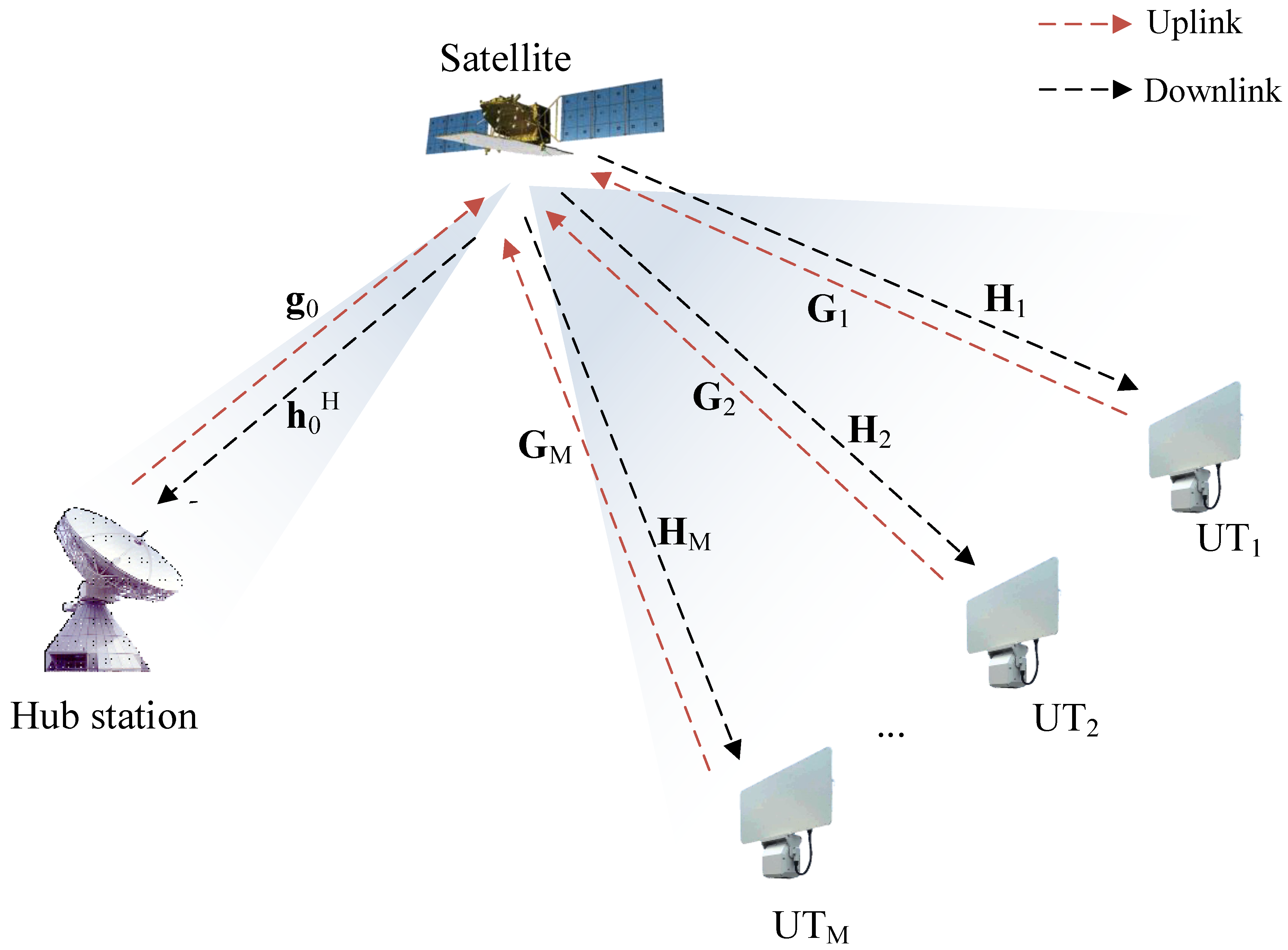

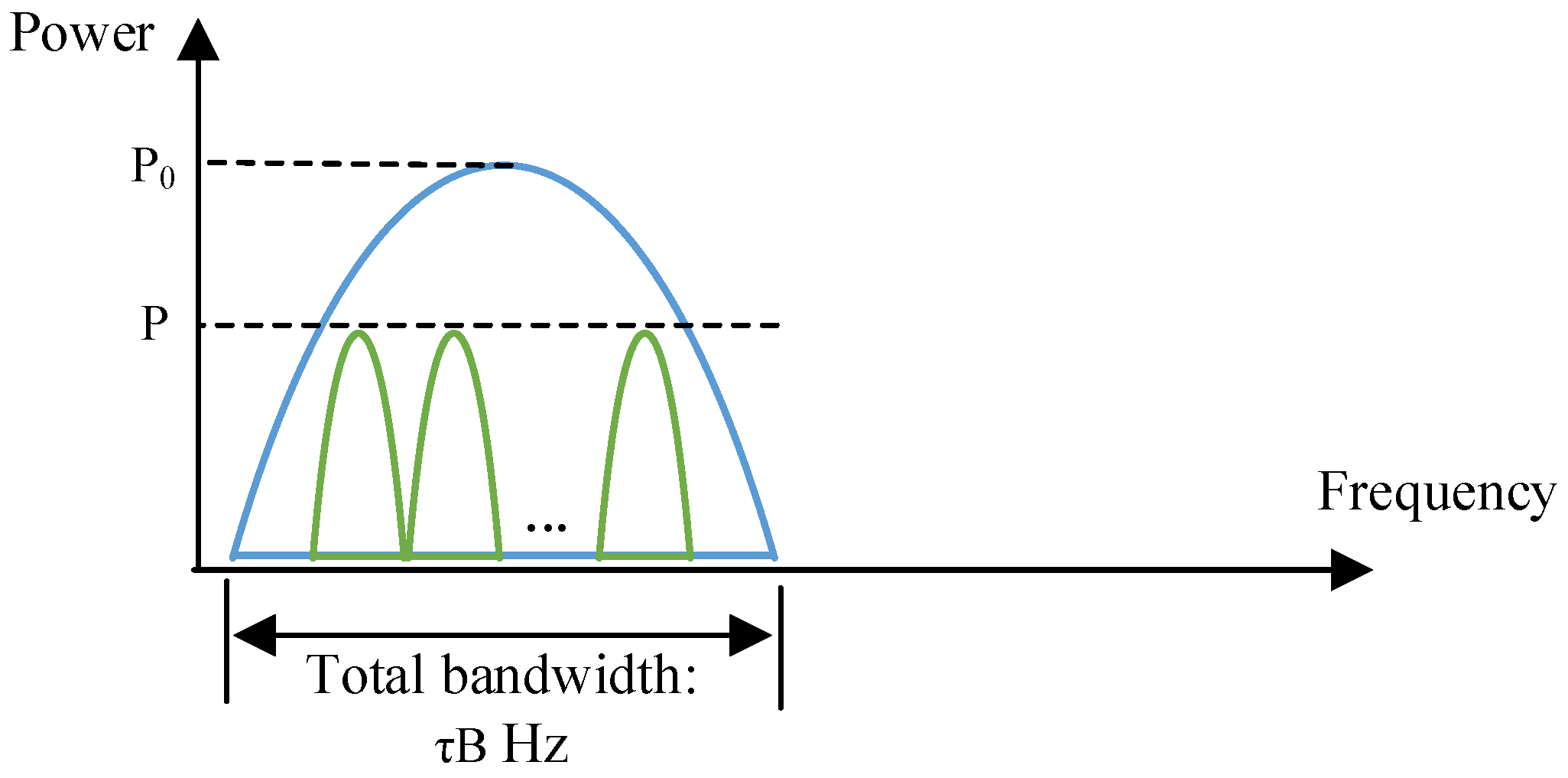

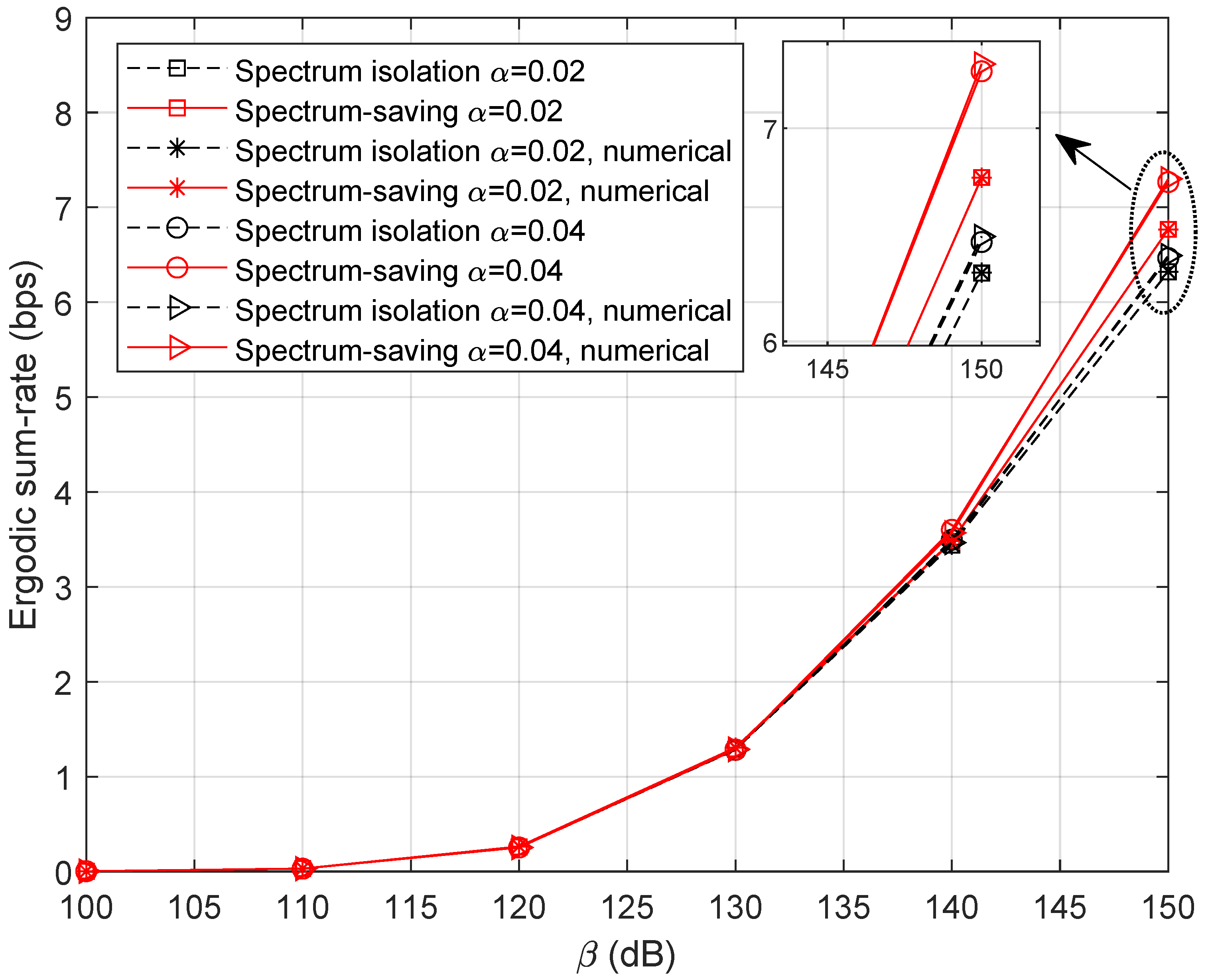
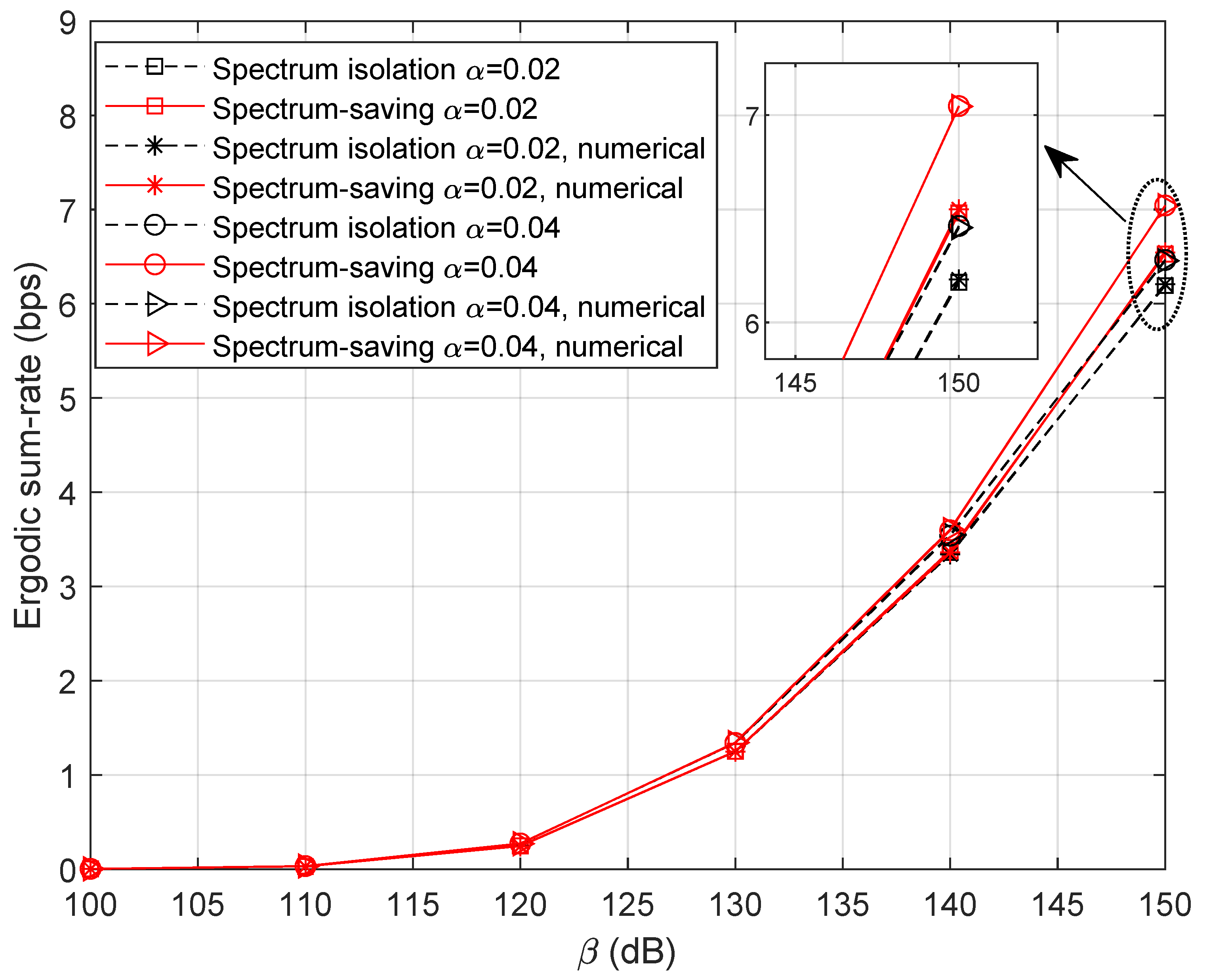

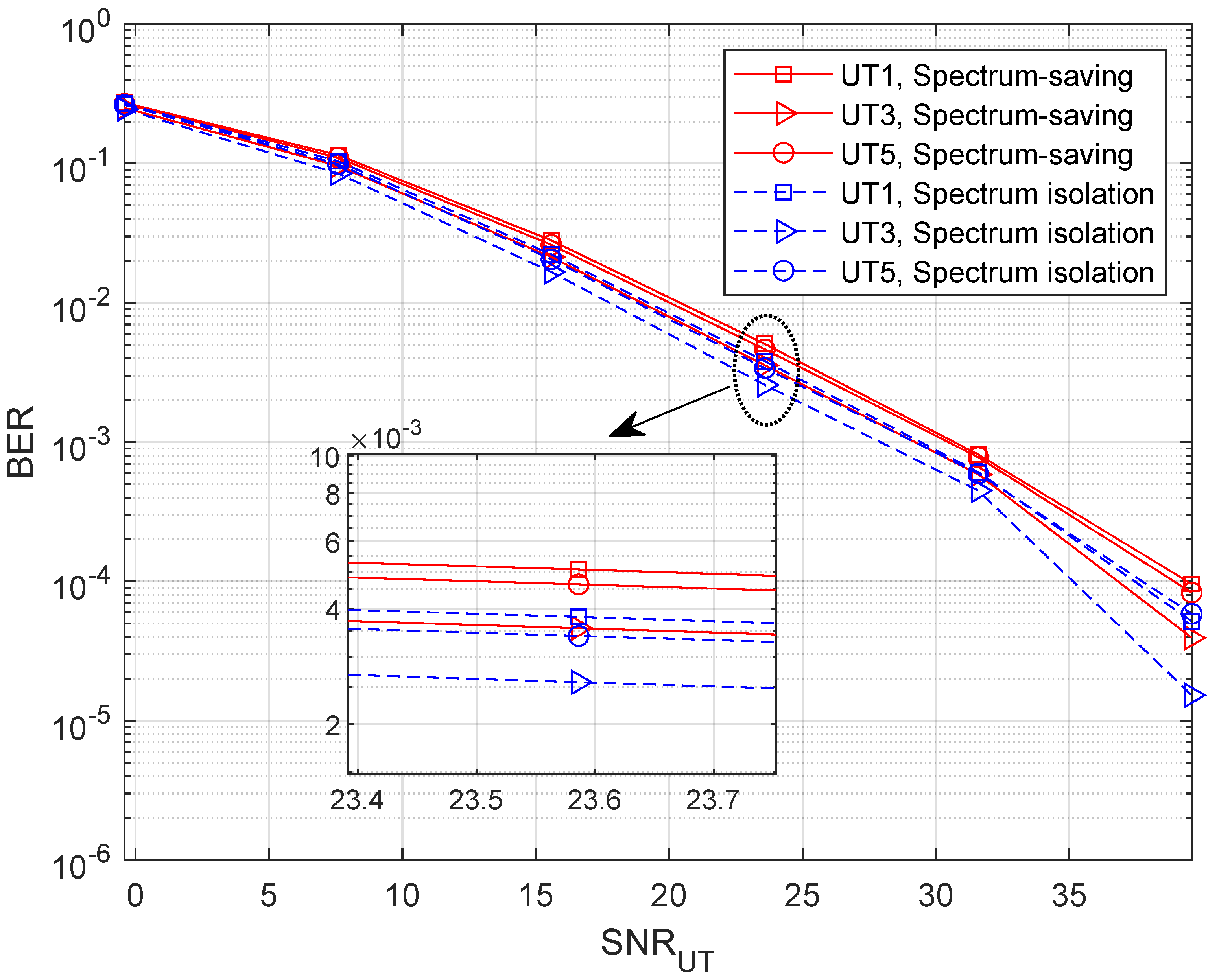

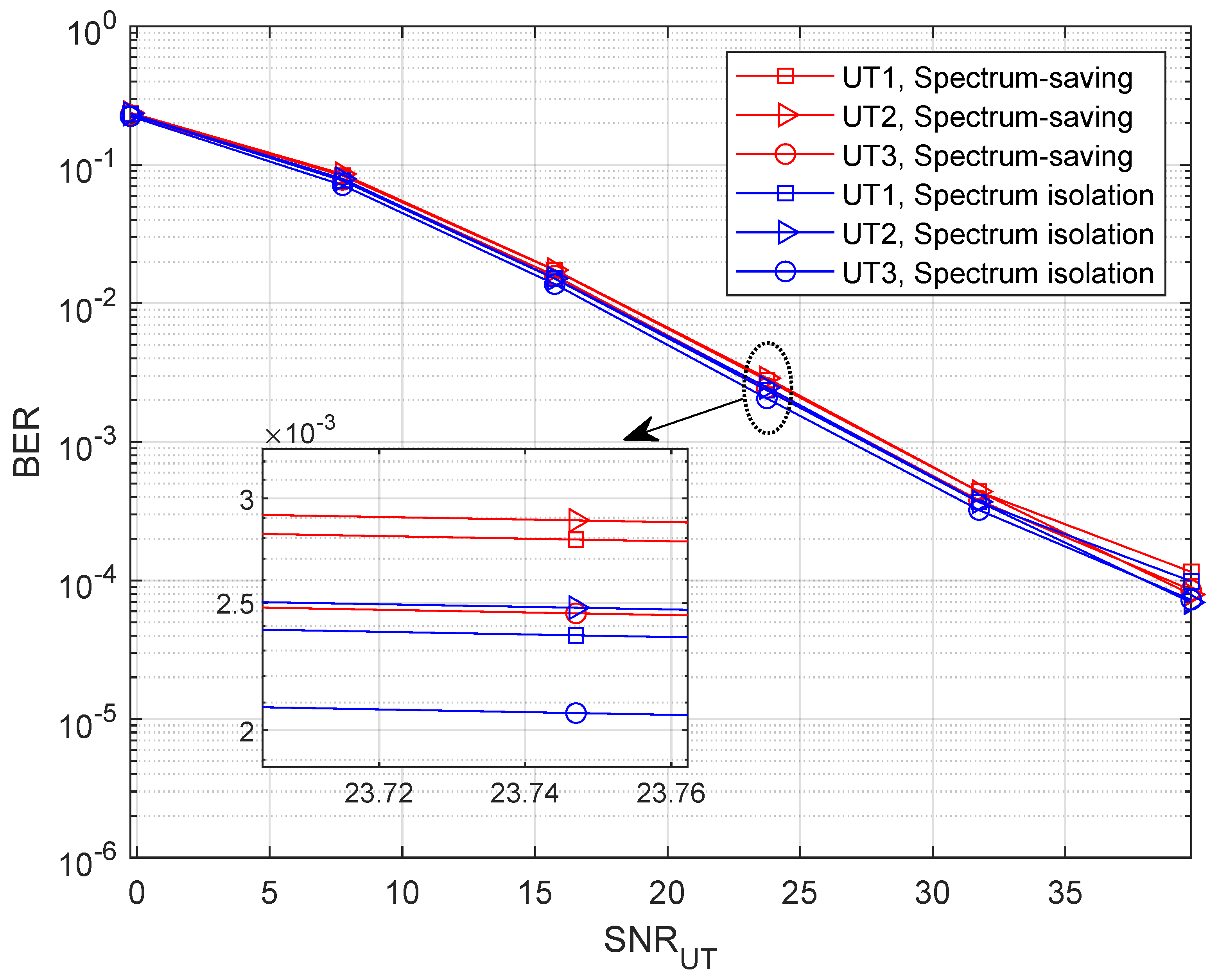


Disclaimer/Publisher’s Note: The statements, opinions and data contained in all publications are solely those of the individual author(s) and contributor(s) and not of MDPI and/or the editor(s). MDPI and/or the editor(s) disclaim responsibility for any injury to people or property resulting from any ideas, methods, instructions or products referred to in the content. |
© 2023 by the authors. Licensee MDPI, Basel, Switzerland. This article is an open access article distributed under the terms and conditions of the Creative Commons Attribution (CC BY) license (https://creativecommons.org/licenses/by/4.0/).
Share and Cite
Li, T.; Hao, X.; Yue, X. A Spectrum-Saving Transmission Method in Multi-Antenna Satellite Communication Star Networks: Sharing the Frequency with Terminals. Entropy 2023, 25, 113. https://doi.org/10.3390/e25010113
Li T, Hao X, Yue X. A Spectrum-Saving Transmission Method in Multi-Antenna Satellite Communication Star Networks: Sharing the Frequency with Terminals. Entropy. 2023; 25(1):113. https://doi.org/10.3390/e25010113
Chicago/Turabian StyleLi, Tian, Xuekun Hao, and Xinwei Yue. 2023. "A Spectrum-Saving Transmission Method in Multi-Antenna Satellite Communication Star Networks: Sharing the Frequency with Terminals" Entropy 25, no. 1: 113. https://doi.org/10.3390/e25010113



